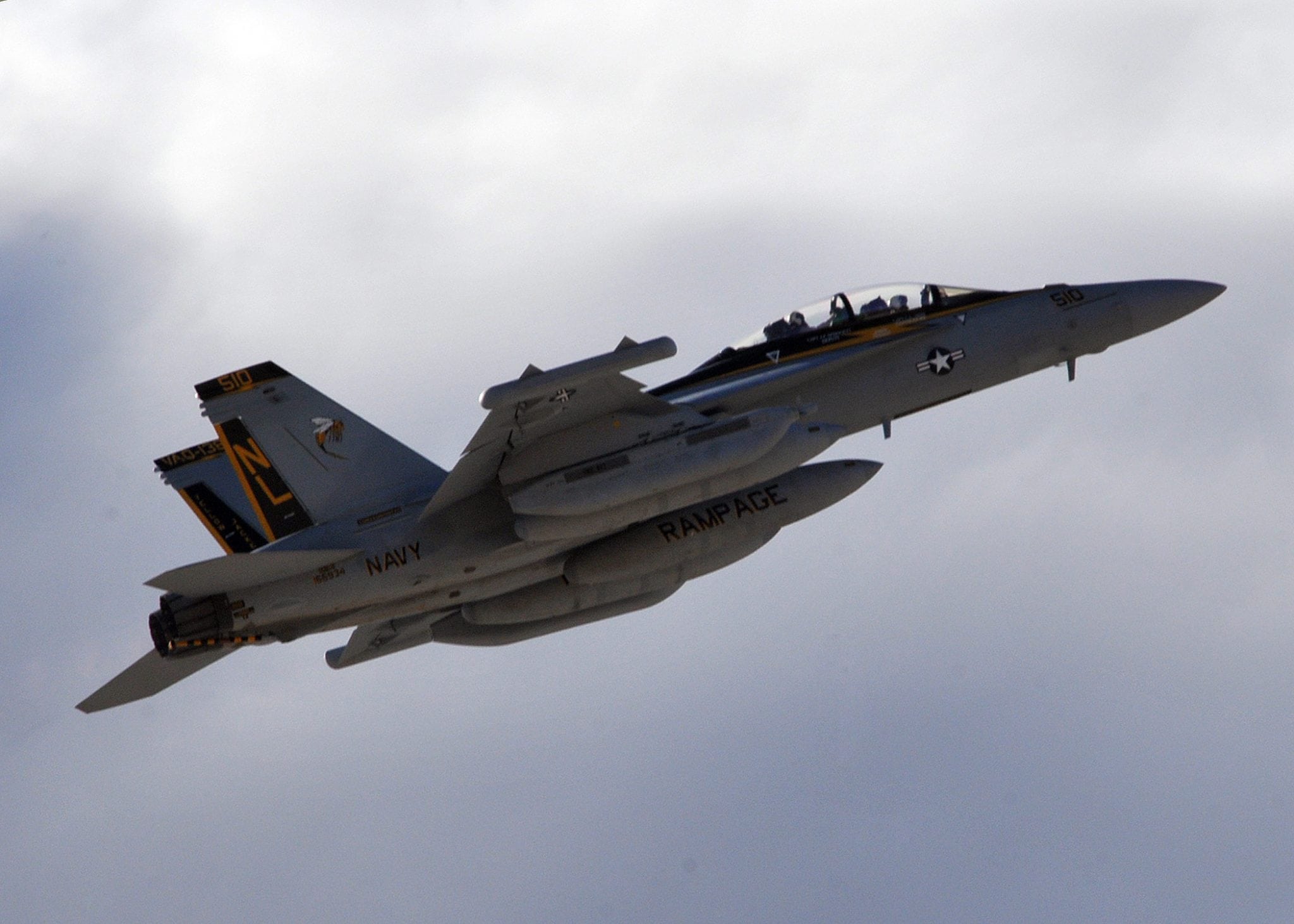 |
An EA-18G Growler of Electronic Attack Squadron VAQ-138
aircraft takes off following a stop on Crete returning
to Whidbey Island, Wash., after a six-month deployment
to Iraq. The Growler uses ALQ-99 pods and is the target
platform for the NGJ.
(U.S. Navy photo by Paul Farley/Released) |
The Naval Air Systems Command (NAVAIR) Next Generation Jammer (NGJ) program office said it expects to release a Request For Proposals on the NGJ Technology Development (TD) phase this summer. The NGJ Airborne Electronic Attack (AEA) system is meant to replace the ALQ-99 jamming pods now on the EA-18G Growler and achieve Initial Operational Capability in 2020. With a Milestone A decision and TD contract award in third quarter 2013, competing contractors will prototype technologies for Engineering and Manufacturing Development (EMD). A Milestone B decision and single EMD contract award are due in 2015. EMD testing is expected to prove the Next Generation Jammer ready for fielding and start Low Late Initial Production in 2018.
BAE, ITT/Boeing, Northrop Grumman and Raytheon received NGJ Technology Maturation (TM) contracts in 2010. They continue to build and test components and scaled subsystems. The TD phase starts system-level prototyping and testing. NAVAIR has released a draft Performance Specification and the draft Statement of Work for industry comment.
The NGJ will enable the EA-18G to engage the radars, communications and data links of Integrated Air Defense Systems. Compared to the high- and low-band pods developed for the EA-6B Prowler and inherited by the Growler, the new system aims to increase dramatically Effective Radiated Power for significantly greater standoff ranges. The program office notes the jammer will also provide better spectral and spatial agility and precision than legacy systems to improve AEA capabilities against a wide variety of radio frequency targets. (EA-6Bs have been credited publicly with the ability to defeat Improvised Explosive Devices with RF initiators.)
The EA-18G is the only platform now planned for Next Generation Jammer integration. The Program Office explains that while scalable NGJ technologies lend themselves to other platforms, none has been identified or funded. The new jammer nevertheless promises the Growler improved interoperability and increased target capacity to deny, degrade and deceive RF systems. It may work in distributed AEA scenarios with mixed platforms such as Miniature Air Launched Decoy-Jammer, Advanced Anti-Radiation Guided Missile and Unmanned Aircraft Systems. A Growler Electronic Warfare Officer working the NGJ will be able to evaluate tactical inputs from on- and off-board sources to control Electronic Warfare responses. According to the NGJ Program Office, future Electromagnetic Battle Management (EMBM) techniques will maximize AEA coordination and effectiveness against networked, centrally controlled threats. ALQ-99 pods have been upgraded over time with new transmitters and other improvements. The Next Generation Jammer leverages the rapidly upgradeable jammer technique paradigm begun with the ALQ-99. However, a new Open System architecture will allow NGJ future growth to meet the anticipated threats with easier, less expensive hardware and software updates. Improved health and maintenance capabilities will also optimize NGJ availability in the fleet.
NAVAIR has developed a comprehensive NGJ test plan starting in Fiscal 2016 and culminating in an Operational Test (OT) in Fiscal 2019. Testing starts with anechoic chamber and on-aircraft tests at Patuxent River Naval Air Test Center, Md., to prove the system can meet design specifications and operate on the EA-18G. Operational Testing to validate warfighting and readiness capabilities will draw on laboratories and test aircraft at Naval Air Warfare Centers China Lake and Point Mugu, Calif. The program office notes that because NGJ represents new technology and a substantial increase in output power, several electronic warfare chambers, laboratories and specialty facilities are being upgraded. The anechoic chamber of the Air Combat Environment Test and Evaluation Facility/Advanced Systems Integration Laboratory (ACETEF/ASIL) at Patuxent River, for example, is being modified for NGJ tests starting in Fiscal 2017. Point Mugu will use a High-Power Electronic Attack Technique Radiation (HEATR) chamber to evaluate pod-level technique generation. Naval Surface Warfare Center Crane in Indiana will test the reliability/supportability of the pods using specially designed high power test chambers.
Navy Squadron VX-23 at NAS Patuxent River will fly aeromechanical and mission system testing on an EA-18G in the Atlantic Test Range. Early aeromechanical testing will start in late Fiscal 2016 and run through Fiscal 2018. Squadron VX-31 at China Lake will perform software development testing and mission system testing out on the Echo Range with additional threat simulations for beam characterization.